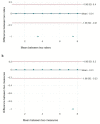Turkish validity and reliability of the level of sitting scale in children with cerebral palsy
- PMID: 37476883
- PMCID: PMC10387952
- DOI: 10.55730/1300-0144.5621
Turkish validity and reliability of the level of sitting scale in children with cerebral palsy
Abstract
Background: The Level of Sitting Scale (LSS) is a valid and reliable classification index that categorizes sitting ability. The aim of this study is to establish the Turkish validity and reliability of the LSS in children with cerebral palsy (CP).
Methods: In total, 165 children (75 girls and 90 boys) between the ages of 4 and 18 years who were diagnosed with CP were included in the study. All children were evaluated by two independent physiotherapists for the interrater reliability analysis of the LSS and were reevaluated 1 week later by the same physiotherapist for the intrarater reliability analysis. The Gross Motor Function Classification System (GMFCS) was used for validity analysis.
Results: The intrarater reliability analyses of the LSS showed an intraclass correlation coefficient of 0.999 (ICC 95% CI [0.999-1]),and the interrater reliability analyses showed an intraclass correlation coefficient of 0.998 (ICC 95% CI [0.998-0.999]). A statistically significant, negative, and strong correlation was found between the GMFCS and the LSS (p < 0.001, r = -0.770).
Discussion: The Turkish version of the LSS in children with CP is a valid and reliable scale. The Turkish LSS can be used by researchersand clinicians in research and to determine the sitting level of children with CP.
Keywords: Cerebral palsy; children; reliability; sitting level; validity.
Conflict of interest statement
The authors report no conflicts of interest.
Figures
Similar articles
-
Inter-intra observer reliability and validity of the Turkish version of Trunk Control Measurement Scale in children with cerebral palsy.Acta Orthop Traumatol Turc. 2019 Sep;53(5):381-384. doi: 10.1016/j.aott.2019.04.013. Epub 2019 Jul 11. Acta Orthop Traumatol Turc. 2019. PMID: 31303422 Free PMC article.
-
Association between gross motor function and postural control in sitting in children with Cerebral Palsy: a correlational study in Spain.BMC Pediatr. 2015 Sep 16;15:124. doi: 10.1186/s12887-015-0442-4. BMC Pediatr. 2015. PMID: 26376627 Free PMC article.
-
Psychometric properties of the Viking Speech Scale-Turkish version for children with cerebral palsy aged 4-18 years based on live and video-based observation.Int J Lang Commun Disord. 2023 May;58(3):687-703. doi: 10.1111/1460-6984.12810. Epub 2022 Nov 25. Int J Lang Commun Disord. 2023. PMID: 36426770
-
Measurement properties of the Gross Motor Function Classification System, Gross Motor Function Classification System-Expanded & Revised, Manual Ability Classification System, and Communication Function Classification System in cerebral palsy: a systematic review with meta-analysis.Dev Med Child Neurol. 2021 Nov;63(11):1251-1261. doi: 10.1111/dmcn.14910. Epub 2021 May 24. Dev Med Child Neurol. 2021. PMID: 34028793
-
Socioeconomic Status Influences Functional Severity of Untreated Cerebral Palsy in Nepal: A Prospective Analysis and Systematic Review.Clin Orthop Relat Res. 2019 Jan;477(1):10-21. doi: 10.1097/CORR.0000000000000476. Clin Orthop Relat Res. 2019. PMID: 30179955 Free PMC article.
References
-
- Rosenbaum P, Paneth N, Leviton A, Goldstein M, Bax M, et al. A report: the definition and classification of cerebral palsy April 2006. Developmental Medicine and Child Neurology. 2007;109(suppl 109):8–14. - PubMed
-
- Matthews DJ, Wilson P. Cerebral Palsy. In: Molnar GE, Alexander MA, editors. Pediatric Rehabilitation. 3rd ed. Philadelphia, USA: Hanley and Belfus Inc; 1999. pp. 193–217.
-
- Turk M, Weber R, Pavin M, Geremski C, Brown C. Medical secondary conditions among adults with cerebral palsy. Archives of Physical Medicine and Rehabilitation. 1995;76:1055–1062.
MeSH terms
LinkOut - more resources
Full Text Sources
Medical
Miscellaneous


